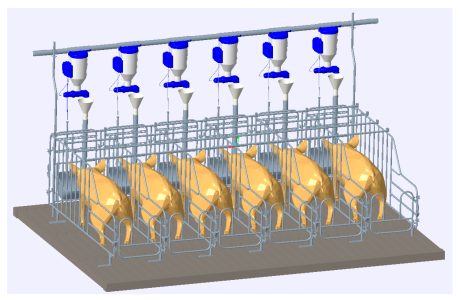Feeding pigs individualized diets based on real-time data or precision feeding could cut costs and environmental impacts while maintaining animal performance, according to new research from the University of Guelph in Canada.
“Individual precision feeding means daily tailoring diets for each one of the animals in our pens. So, we use real-time data obtained for each one of these animals,” said Aline Remus, Associate Professor at the University of Guelph.
She found that tailoring individual pigs’ diets can reduce nitrogen and phosphorus excretion by 40% and decrease greenhouse gas emissions by 7% compared to traditional group feeding methods.
The technique can also decrease feeding costs by 12% while reducing labor requirements for handling fees and caring for animals, Dr Remus said.
Using precision feeding techniques in pig growing operations can reduce production cost by 8%, protein and phosphorus intake by 25%, and excretion by 40%, according to a paper published by Oxford University Press.
Traditional phase feeding provides the same diet to all animals in a pen during a specific growth phase. In contrast, precision feeding adjusts each animal’s diet daily based on individual data, gradually decreasing nutrient supply as animals approach their requirements.
“We not only can feed these animals closer to the requirements, but we can also tailor their growth,” Dr Remus said.
Changing the mix of amino acids and energy in the pigs’ diet changes the growth rate of the animals and their body composition.
Testing metabolic responses
The research involved 60 pigs divided equally between conventional group phase feeding and individual precision feeding systems. To test how the different feeding methods affected metabolic responses to stress, researchers used a 24-hour fasting protocol.
“Fasting 24 hours is a great model for physiological stress,” Dr Remus said, adding that such extended periods without feed can worsen feed conversion by 7 points and increase costs by three US dollars per pig.
Results showed that despite receiving 23% less lysine, precision-fed pigs maintained similar blood concentrations of the nutrient compared to group-fed animals.
“We have a very similar plasma concentration, which means these animals are probably very efficient, at preserving and keeping this lysine,” she said.
Efficiency findings
The precision-fed pigs broke down nitrogen more efficiently, demonstrated better nitrogen retention and showed enhanced metabolic pathways related to antioxidant defenses and stress response.
The research suggests precision-fed animals are more reactive and can quickly mobilize their reserves and respond better to oxidative stress than group-fed pigs. This finding surprised Dr Remus, given that precision-fed animals receive fewer nutrients overall.
Market opportunities
The study also found evidence that precision-fed pigs may produce different muscle proteins, including increased carnosine, an antioxidant compound that some companies are trying to enhance in meat products.
“There is an opportunity to actually not only decrease environmental impact, but also have a niche market,” Dr Remus said.
The research concludes that precision feeding creates metabolically flexible animals that can adapt to nutritional challenges while using resources more efficiently.
“In practice, this means that we can formulate diets closer to the requirement of the animals, especially in terms of amino acids, without compromising resilience,” Dr Remus added.

